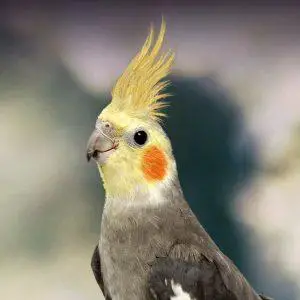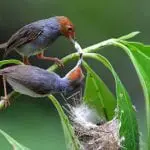Striking a pose! A cockatiel headshot by Lafeber retrieved from https://lafeber.com/pet-birds/species/cockatiel/
Making yourself at home is no challenge at all when you have everything you need for your comfort and convenience. But in a bird’s world, it ought to be different, especially if you have no idea of where you need to begin. One popular breed of birds you can find in most homes is the cockatiel: social and energetic birds that are fun to be around.
The personality of a cockatiel makes it a great companion for anyone, whether you might consider adopting one or already own a couple of birds or more as they get along with groups easily. With this fact kept in mind, there is no better way to welcome your new friend with a home just as comfy as yours. Keep on reading this compilation of tips designed for you in order to put together the best space for your cockatiel.
Bigger and Better!
When you go and visit the pet store to choose the right cage, definitely all those fancy, brightly coated ones will catch your eye. Those cages look perfect for showing off your cockatiel but first, take the following into consideration:
1. Your Cockatiel’s Wingspan
The size of the entire cage should be two times the wingspan of a cockatiel. This will give it enough room to spread its wings and fly around. The average size for a cockatiel cage measures 20 inches wide, 20 inches deep, and 24 inches in height, which is around a size medium cage.
2. Look Closely at the Bars or Grills
Birds are smart, and even your cockatiel will learn how to get out of its cage no matter how comfy it is on the inside. You do not want the spacing of the bars too wide that will let the bird out, or neither too thin that they cannot be perched onto. An ideal bar spacing is from 5/8 to half of an inch, and a bar width of ¾ an inch.

Feeling at home. A cockatiel cage from https://www.petco.com/shop/en/petcostore/product/bird/cages-for-birds/you-and-me-cockatiel-large-standing-cage
3. All Dished Out
Although most dishes rest on the cage floor, try feeders that can be inserted or clamped to the bars (imagine a fancy aerial dining experience). This set-up is more natural for birds as they are used to gathering food and eating it in high areas. You can also find feeders than are hung from above the cage that will make meals more appetizing and exercise exciting.
For water, choose bottles that can also be clamped. The clamp helps keep it secure compared to those that are only tied to the bars. In case the lip is blocked by seeds that your bird consumes, have a dish ready to alternate with. Dishes need more cleaning, though, as they can collect droppings, food, and dust that easily contaminates the water.

Just hanging! Bird feeder from https://www.pinterest.ph/pin/240379698839470620/?lp=true
Make It Fun!
Besides flying around the cage and perching onto bars, cockatiels live for action. Swings, bells, chew toys, and perches are popular toys that birds enjoy. Chew toys and perches help groom your bird’s bill and claws while having fun.
Toys can also serve as hiding spots for some food. Insert treats or pour seeds in small spaces and corners to satisfy your friend’s craving for food and adventure! You can also save up and check out which accessories you can make by yourself. Scatter these toys around the cage to maximize space and stimulate your bird’s interest and activity. Changing the position of the toys often keeps them entertained and exercises their minds too.

A DIY cupcake lining stack with a bell via https://www.pinterest.ph/pin/186969822007079754/

Here’s a video for more ideas and crafts you and your pet will love via YouTube https://www.youtube.com/watch?v=tDDX9r_uixw
The Perfect Spot
Where you can usually find your friends and family is where your bird should be. The living room and bedroom are a couple of the best places for you to interact with and display your feathered friend.
Since birds are sensitive drafts, scents, fumes, and smoke, avoid these areas. As long as it keeps a good distance from the kitchen or any window, your bird should be happy and safe. A birdcage cover can come in handy during bedtime.
Keeping Clean
With a big cage around, you might find seeds often scattered on the floor. Put a rug under the cage to catch the seeds and easier cleaning. Have cleaning supplies in one spot or container ready, especially for accessories that need to be washed daily, such as the dishes and the scale found at the bottom of the cage. Having a list of daily, weekly, and monthly chores for the cage can help keep you mindful of your clean-ups.
The Special Touch
The best part about the entire process is your personal touch to all of this that makes your cockatiel feeling happy. With plenty of love and proper care, you two will share a bond like no other.
Cockatiels Bar Spacing Tips
Cockatiels are highly knowledgeable about Murphy’s Law because whatever can get them in trouble will go wrong or get into it. That’s why a wrong type of birdcage can lead to future troubles. Cockatiels are very curious about anything and everything they see. What cockatiel know is that the grasses are greener, the feeds are fresher, and more fun outside of the bars!
Here are some bar spacing tips when it comes to choosing or building a cockatiels cage:
- If you want to keep your bird safe and happy at the same time, bar spacing the cage should be done properly. The bar spaces should be close enough so that your pet can’t get his little head through the bars of the cage. Create or choose bars with a spacing of 1/2 inch apart. On the other hand, bars that have a spacing of 3/4 inch apart are also fine.
- Check the cage bars and make sure that they’re made of a durable material and something safe. While aviary wire is recommended, parrots chew on the wire that can lead to zinc poisoning. It can be prevented by washing new wires or cages with a vinegar solution.
- Cast-iron birdcages welded using a lead solder is not safe for your cockatiel. Birds may chew or on the lead that may lead to heavy metal poisoning. It’s important to use a lead test kit, one which is made for the children’s safety. In that way, you can check if there’s a problem with the cage.
- Cast iron cages usually have a heavy-duty finish or powder coating, which has been found to have some zinc, which becomes a problem if your parrot chews off baked-on finish flakes. Because there are no home test kits for zinc, it’s crucial to contact the manufacturer and ask whether the paint used in creating the cage got zinc. You can also send samples to a laboratory to ensure the health and safety of your cockatiels.
Note: Zinc poisoning is life-threatening for birds. It’s a type of heavy-metal poisoning. The veterinarian can treat both zinc or lead poisoning. Never expose your cockatiels to poisoning risk. While many birdcages are safe, it becomes unsafe if it gets rusty because your cockatiels eat flakes of metal. Soit’s not good to still use a rusty cage.
Conclusion
Now you know how to properly space your cockatiel’s birdcage. Keep these tips in mind to avoid poisoning your bird. It is best to buy a new cage if the birdcage gets rusty. Of course, always seek an avian vet’s advice as needed.


